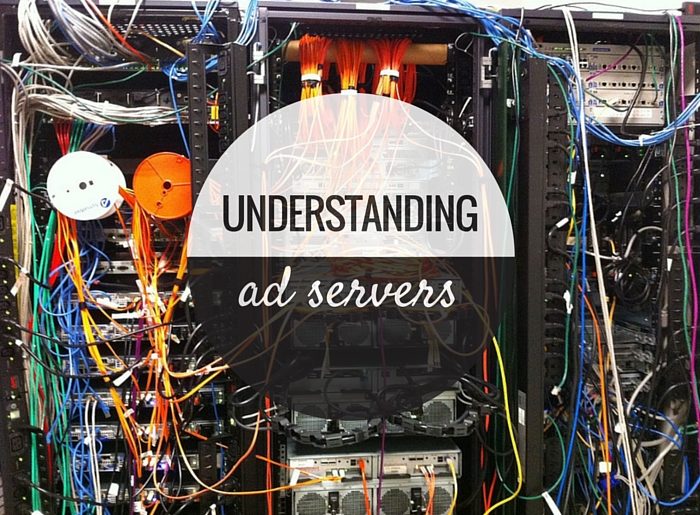In this post, we’ll explore some of the most popular ad serving platforms and help you to decide which one is best for you.
Running ads is one of the main ways websites monetize their content. And advertisements need to be managed, replaced and tested constantly for improvement. This where an ad server comes in. It helps webmasters manage all of their ad space on one or more sites from one central console.
In this post, we’ll explore some of the most popular ad serving platforms and help you to decide which one is best for you. But, first let’s understand how ad servers work in a little more detail.
What is an Ad Server?
An ad server stores information about ads and delivers them to one or more web sites for display to visitors. Ad servers also track ad displays, clicks on ads, and generate statistical reports. Ad servers can also selectively display ads to site visitors based on predefined criteria.
Ad server platforms are broadly of two types, hosted versions that are run and maintained on an ad server company’s site, and self-hosted versions that you install and maintain on your own server.
We’ll be looking at DFP, OpenX, Broadsreet, adColt, Kevel (previously Adzerk) and AdButtler hosted ad servers as well as Revive and OIOPublisher self-hosted ad servers.
Hosted vs Self-Hosted Ad Servers
Let’s take a quick look at the pros and cons of both hosted ad server platforms and self-hosted ad servers.
Hosted Ad Server Pros
- No Installation: Nothing to install. You just sign up for service and everything is already installed for you.
- Updates: All updates to the platform are installed for you.
- Support: In general support is of a higher quality with hosted platforms and is more readily available.
- Speed and Reliability: Most hosted platforms are monitored for problems on a continuous basis. So speed issues and problems are solved quickly. Usually, before you are even aware of them.
Hosted Ad Server Cons
- Price: The cost of a hosted ad server is higher than self-hosted.
- Customization: Most hosted ad servers can’t be customized to your exact needs. A few do offer very limited customization.
- Data Control: Your data is stored on the hosted ad server and is not 100% under your control.
Self-Hosted Ad Server Pros
- Price: The price of a self-hosted ad server script is a one-time fee. Your only ongoing cost is that of the server you are running it on.
- Customization: You can modify or hire a programmer to modify a self-hosted script to meet your exact needs.
- Data Control: Your data is on your server and under your control.
Self-Hosted Ad Server Cons
- Installation: You need to install the ad server script on your server. This takes a little technical knowledge.
- Updates: You have to watch for updates and install them yourself.
- Technical Issues: If a technical issue with the script or server arises, you have to fix it yourself.
Now that you’re aware of some of the pros and cons of hosted ad servers and self-hosted ad servers, let’s take a look at some of the popular hosted ad server platforms available.
Hosted Ad Servers
Here are the most popular hosted ad server platforms.
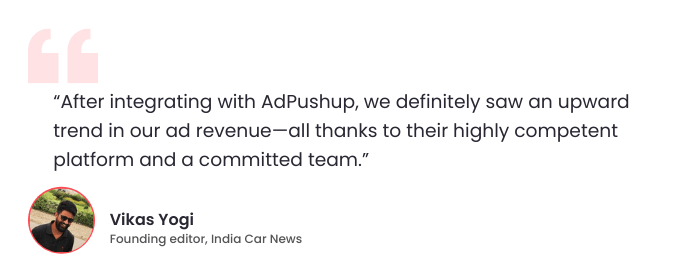
1. Kevel (previously Adzerk)
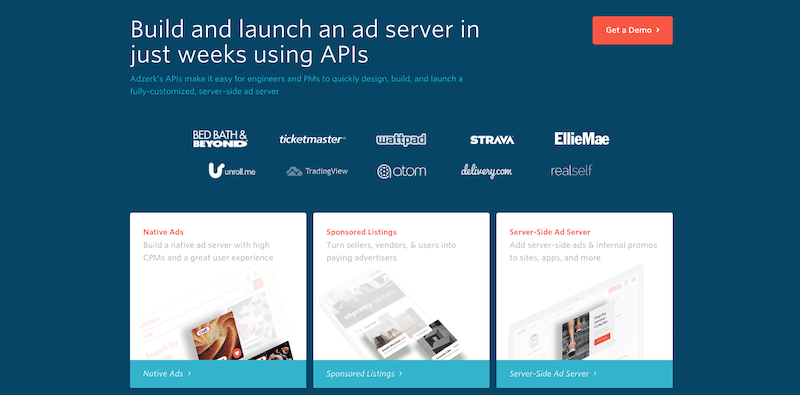
Kevel is a suite of APIs that make it easy for engineers and PMs to design, build, and launch a fully-customized, server-side ad server. Sold as an infrastructure-as-a-service for enterprises, plans start in the $3K-$5K/month range and scale based on needed features and monthly request volume.
Pros
- Flexibility: Multiple APIs and a robust feature-set mean you can build an ad platform promoting native ads, sponsored listings, standard banners, internal content, audio ads, in-stream commercials, VR ads, and more
- Server-Side: You can cut down on ad response times by not using JS
- Technical Support: Support engineers, AMs, and dedicated Slack channel are available at higher tiers
-
Industry Trust: With Bed Bath and Beyond, TicketMaster, EllieMae, and others, Kevel has become the go-to solution for large brands who want a customised solution
Cons
- Price: For small to medium sized publishers, the cost to use this ad server platform could be prohibitive.
- API Driven: You’re going to need a tech guy on hand for integration and modifications.
Kevel is highly scalable, extensible, and versatile. It is better suited for large publishers/enterprises that have technical staff on hand. They are a major player in the ad server space.
2. DoubleClick for Publishers (DFP) (Now Google Ad Manager)
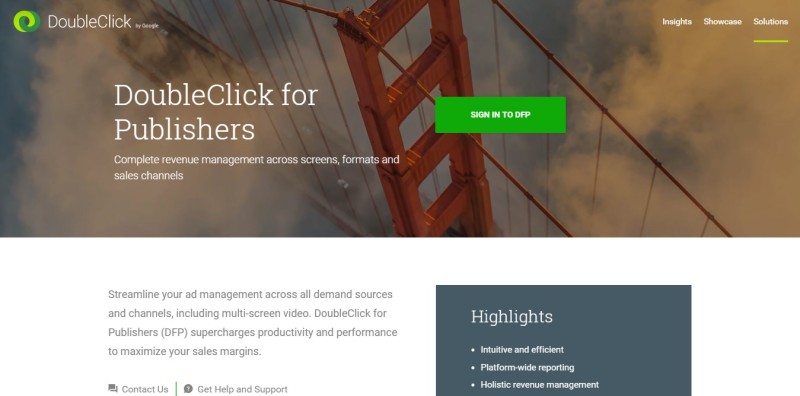
DoubleClick for Publishers is owned by Google. Google purchased DART for Publishers back in 2008 and renamed it DoubleClick for Publishers. DFP is free to use if you’re serving less than 90 million ad impressions a month. DFP also offers premium services for publishers that have large sales teams who need more advanced features. This is one of the most popular ad serving platforms currently available.
Pros
- Free: Use is free for publishers that serve less than 90 million ad impressions per month.
- AdSense Integration: Easily integrates with AdSense. This is a big plus if you heavily rely on AdSense revenue. While using multiple networks, you can maximize your revenue by having your AdSense ads displayed in unsold ad spots.
- Intuitive User Interface: DFP is quick to learn and easy to use. The interface is extremely intuitive and great for beginners.
- Great Reporting: The reporting tools are robust and extensive. They are very flexible and easy to configure just the way you want.
- Targeting and Segmentation: With Google’s extensive data collection practices, DFPs targeting and segmentation features can’t be matched by any other ad serving platform.
- Support: Google has always been known for great support. Their DFP support team is top notch, helpful and friendly.
Cons
- Price: When something is free, you’re the product. And Google could also suddenly start charging with little notice to publishers.
- Owned by Google: Google is known for suddenly dropping products and services. We don’t think they’ll drop DFP, but the possibility exists.
DoubleClick for Publishers is one of the easiest ad server platforms to use. Whether you’re just starting out with ad serving or if you need extensive reporting, this may be the ad serving platform for you.
3. OpenX Ad Server
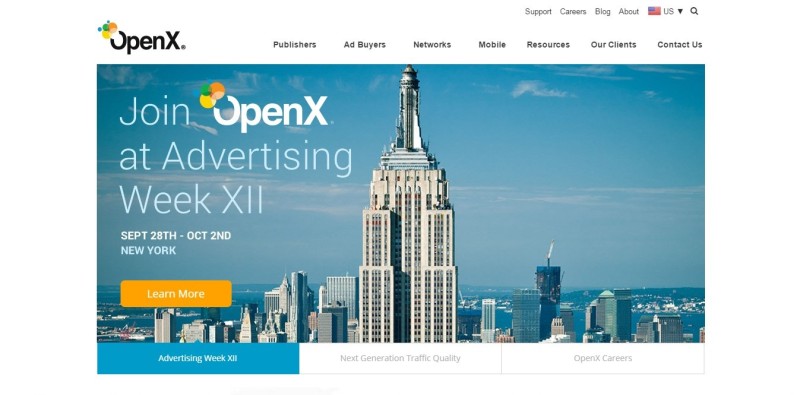
OpenX Ad Server started out many years ago as an open source self-hosted ad serving script. Over the years, they moved away from being open source to being a paid hosted service. The original self-hosted open source script was reborn as a free product named Revive, which we look at that one a little later in this post.
OpenX is aimed at the larger publisher that serves a high number of ads per month. They seem to be secretive about pricing, but we did manage to find a few quotes others have received from the OpenX sales team.
The fees we heard are the following: $1,000 setup fee, minimum monthly fee of $1,200 (includes 50 million ad impressions), and $17.50 per 1 million ad impressions over the 50 million per month. We’ve also heard that recent quotes are even higher. One source said they were quoted a $20,000 setup fee and much higher monthly fees. As you can see, OpenX is not an entry level ad serving platform.
Pros
- Own Domain: This is a big plus. OpenX lets you use your own domain name with their hosted ad serving platform. This way your ads are served under your brand or company name and not the OpenX domain.
- OpenX Ad Exchange: OpenX seamlessly integrates with their own ad exchange where you can sell additional and unsold ad space.
- Forecasting: Access up to 12 months of historical data to forecast traffic and seasonal trends.
- Targeting: OpenX has extensive targeting. You can target ad display by content, geography, viewing device, value pairs, audience and more.
- Platform Integration: OpenX easily integrates with third-party platforms through its open API.
- Support: 24/7 customer support.
Cons
- Little Information: Little information is available on the OpenX website about the actual ad serving platform product benefits. They do have online documentation, but that mostly assumes that you are an experienced user.
- Price: Extremely high priced compared to other ad servers.
- Difficult to Order: They want you to sit through a 1-hour demonstration of OpenX and then deal with a sales person to determine your needs.
If you are a large publisher that needs fast and extensive support, you may want to consider OpenX Ad Server. If you’re a small publisher or have a low ad budget, then OpenX isn’t for you.
One word of caution. If you read comparison articles about ad serving platforms, the majority are comparing the old open source OpenX and not the new hosted incarnation of OpenX Ad Server.
4. Broadstreet Ad Server
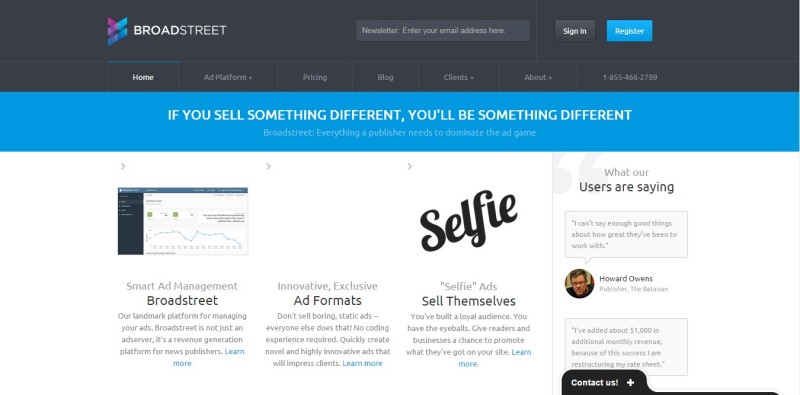
The Broadstreet Ad Server hosted service was designed for the needs of news sites. It can also be used on other types of websites, though. This ad serving platform is an affordable option for small publishers.
Pros
- WordPress Integration: They have a WordPress plugin for placing ad zones in the widget area of the theme you use.
- CDN-Based Delivery: Ads are served from the closest cloud-based ad server to the viewer. This helps to speed up load time.
- Friendly User Interface: The Broastreet user interface is easy to use and fast to learn.
- Price: The price is reasonable. You can start with a free plan to see if it works for you. Other Broadstreet plans range from $10 to $50 per month per 1mm served. They have a price estimator on their site.
Cons
- Shared Domain: All clients share the same domain for serving ads.
- Limited Technical Support: They only offer a ticket based support system. You can’t pick up the phone and get live technical support.
- Not Feature Rich: This could actually be a pro or a con. It does not have all the features of the larger services but is easier to use.
If you are a small publisher or just starting out with ad serving, Broadstreet should be on your list to check out. Sign up for a free account and see if it has the features you need.
5. adColt Ad Server
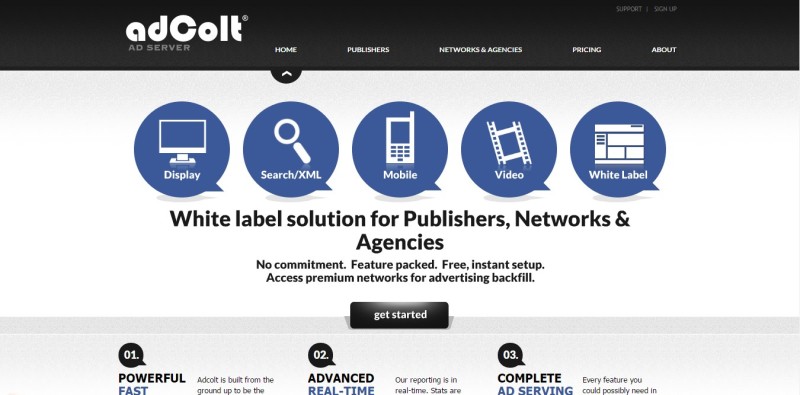
adColt is a white label ad serving platform. Their pricing is straight forward and the service is feature rich. This one is suitable for both small and large publishers. adColt also has click-fraud monitoring and live email reporting.
Pricing is a flat .02 CPM regardless of the number of ads you serve.
Pros
- Ad Formats: adColt will deliver a wide variety of ad types. The types of ads include banner, text, rich media, pop-unders, mobile, overlays, pre- and post-roll video ads to name a few.
- Technical Support: 24/7 technical support is available by phone, email, and chat.
- White Label: You can customize the platform with your own logo and color scheme. You can also use your own domain name.
- Click Fraud System: adColts system will analyze each click and ad impression to help determine if they are human generated or computer generated. Invalid traffic is automatically reported to you.
- Reporting Tools: Their reporting tools are real-time, extensive and give you the stats you need to optimize your ad performance.
Cons
- No Discounts: The flat rate pricing is nice for small publishers, but they do not offer any discounts for larger publishers.
- No Public API: adColt does not have a public API for third-party integration.
- No Multilingual Interface: The user interface is in English only.
This ad server platform has a lot of features at a reasonable price. If you are a small or medium size publisher or need a white label solution, we would recommend that you check them out.
6. AdButler
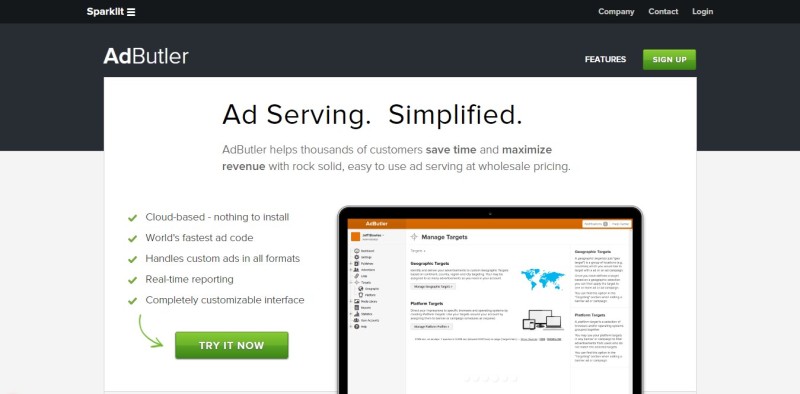
AdButler has been in the ad serving business for over 14 years now. It boasts an impressive list of clients that use their hosted service including Microsoft, MTV, IBM, Hewlett-Packard, and Allstate. They have extremely fast ad delivery and can handle custom ads of all formats.
AdButler has plans starting at $9.95 per month plus .25 per thousand ads delivered.
Pros
- Price: Their ad delivery service is affordable for small publishers.
- Text Ad Support: Text ad blocks are fully supported.
- Multiple Ad Types Supported: AdButler supports all standard banner sizes, Flash, CSS, pop-ups, text ads, videos, interstitials, as well as complicated script ads.
- 30 Day No-Risk Trial: They offer a no-questions-asked 30-day trial. If you’re not fully satisfied at the end of the trial, they will give you a prompt refund.
- Technical Support: They offer both ticket and phone support.
- White Label Interface: You can brand with your own logo and colors.
- Simple User Interface: The user interface is intuitive and easy to use.
Cons
- No Ad Exchange: AdButler does not have its own ad exchange to help you sell your unsold ad space inventory.
AdButler is a good choice for both small and large publishers. Small publishers can take advantage of the scalability this ad delivery platform offers. Make sure you add this to your list of hosted services to try.
7. Epom Ad Server
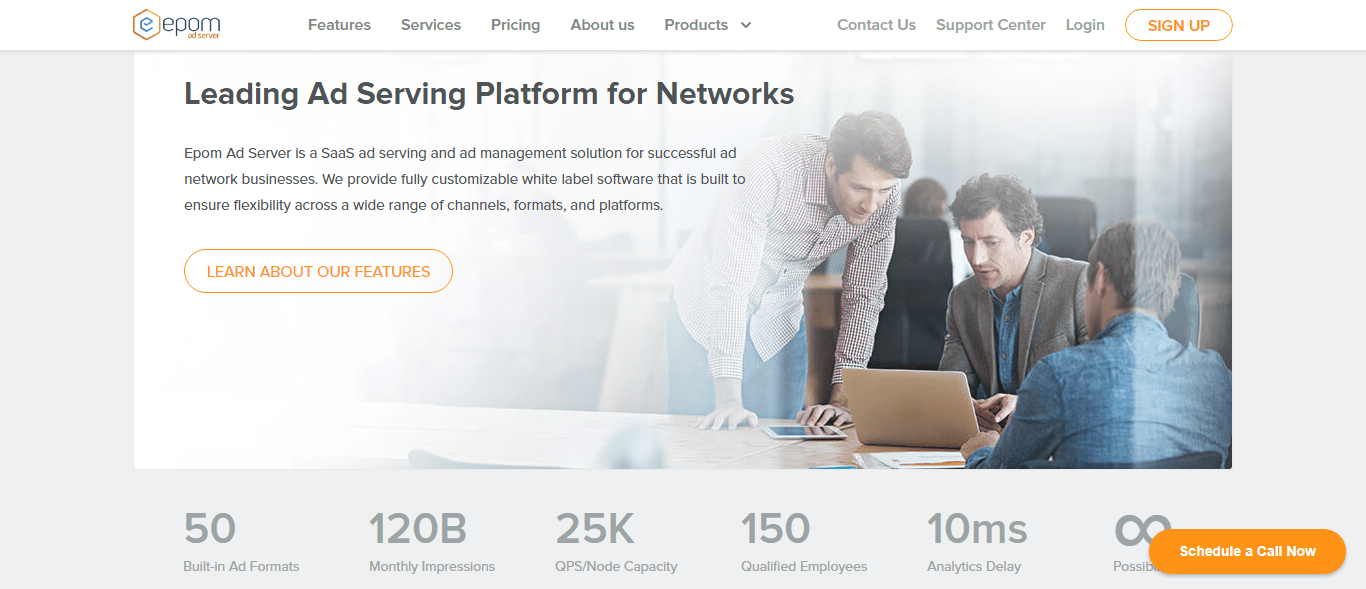
Epom’s cross-platform hosted ad server has been on the market since 2010. It is aimed at ad networks and agencies but works just as well for publishers and advertisers.
Pros
- Free 2 Week Trial: They offer a free, no-credit-card-required sign up for up to 30M impressions for a trial period of two weeks.
- Ad Formats: Epom has 50 built-in ad formats ready to go, including flash, HTML5, rich-media, and the more standard text and text-image ads.
- Epom AdExchange: Ad server clients get hassle-free integration with Epom Market to sell unsold inventory.
- DSP Integration: Integrates directly with Epom RTB platform with over 60+ DSP partners including Index Exchange, Google DoubleClick, TLV Media, etc.
- Fraud Monitoring: There’s a built-in system to monitor impression, click, and conversion fraud. Integrates with Forensiq© for advanced fraud protection.
- Technical Support: Tech support is available 24/7 via phone, chat, and email.
- White Label: You can brand the console with your own logo and colors. The same feature lets you use your own domain for ad serving.
Cons
- Interface: Those who have worked with an intuitive console like DFP will find Epom’s console difficult to understand and use.
- Price: With plans starting with $250/month, the price is on the expensive side for small publishers.
It’s not the easiest platform to use, but it avails an extensive range of features at competitive prices. For medium to large publishers with multiple domains to manage (and an ops team at hand), Epom is definitely worth a shot
Now that we have looked at hosted ad server platforms, let’s move on and take a look at some self-hosted options.
Self-Hosted Ad Servers
Here are the most popular self-hosted ad server platforms. Let’s take a look at them and explore the pros and cons of each.
1. Revive Adserver
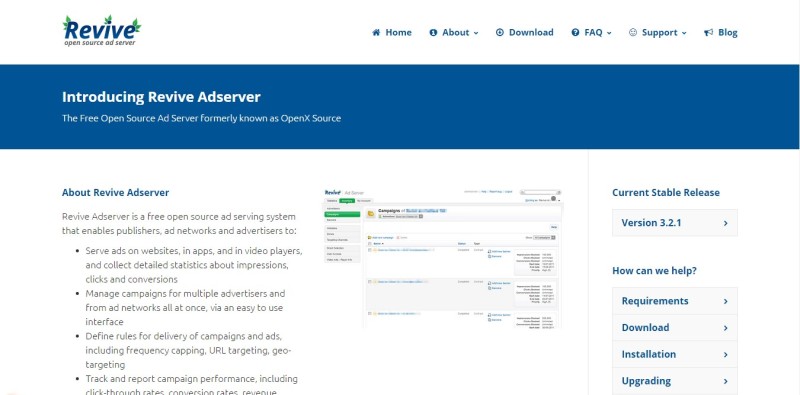
Revive Adserver is a free and open source ad serving script. It has a long history and has gone through several name changes. Its last name was OpenX Source. Even with all its bugs it still remains as a popular choice.
This script was originally a fork of phpAds called phpAdsNew. Who knows how many more name changes are in store for this script.
Pros
- Price: It’s 100% free.
- Extensive Targeting: Revive offers extensive targeting features that allow you to define rules for ad delivery. They include frequency capping, URL targeting, geo-targeting and more.
- Detailed Reporting: Detailed reports are available for ad campaigns. These reports include click-through rates, conversion rates, revenue, eCPM and more.
- No Ad Serving Fees: Your only cost is your server hosting and domain name. There are no fees based on the number of ads delivered.
- AdSense Ad Support: Revive supports the display of AdSense ads.
Cons
- Support: The only support available is a community website. Many support questions are never answered.
- No VAST Support: VAST 2.0 and 3.0 is not supported directly.
- Buggy: This script has been and most likely always will be buggy.
- Server Resource Hog: This is a huge script that uses extensive server resources. It needs to be run on a VPS at a minimum.
- Slow Site Load Time: Many have reported that this script has greatly slowed down the load time of sites displaying ads. Most likely this is because Revive is not being run on a large enough server.
If you’re technically inclined and can fix your own problems, you should give Revive Adserver a spin. Just be prepared to dedicate an entire server to its use.
Revive Adserver is a powerful script but has a big learning curve. If you give it a try, be prepared to have a few sleepless nights learning how to use it.
2. OIO Publisher
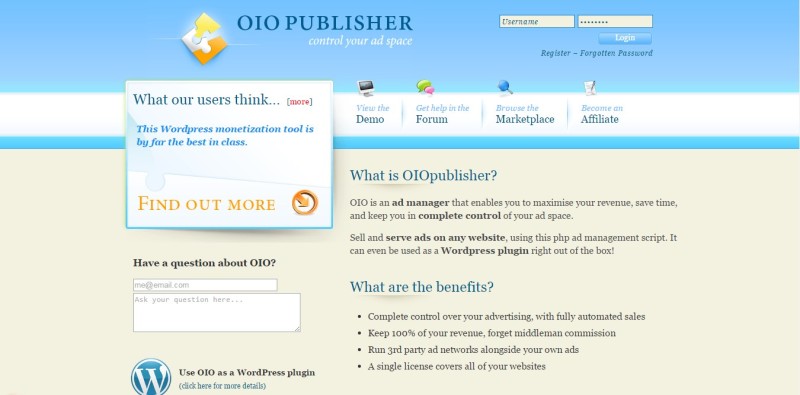
OIOPublisher can be installed as a standalone program or installed on a WordPress site. It costs $47 and the license covers all of your websites.
Pros
- Price: The price is extremely reasonable for what you get.
- OIO Marketplace: You get access to their ad marketplace to sell your unsold ad space.
- Flexible Installation: Can be installed as a standalone program or a WordPress plugin.
- One Click Updates: Easy to update as new versions are released.
Cons
- Limited Support: Forum and email support only. No telephone or priority support is available.
- Client Stats: Client stats are very basic.
If you need a basic ad server with just the basics, then OIOPublisher may be the best choice for you.
Now all that is left to do is start comparing your choices and narrow it down to the best ad server platform for your needs. You may want to try several and then make your final decision.
FAQs
Publishers and advertisers use ad servers to optimize, manage, and distribute ads across multiple paid channels.
Ad networks make money by taking a cut of the ad revenue, or by marking up inventory before selling it. Using the campaign panel of the ad network, the advertiser can monitor and manage the ad’s performance.
Anyone with a large display ad inventory to sell or to serve should consider an ad server. All aspects of your advertising strategy are controlled by your ad server.
A growth blog for professional bloggers and ad ops professionals.
